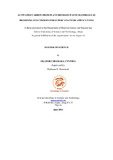Browsing by Title
Now showing items 121-140 of 4790
-
Acoustic boundary conditions at an impedance lining in inviscid shear flow
(Cambridge University PressJournal of Fluid Mechanics, 2016)The accuracy of existing impedance boundary conditions is investigated, and new impedance boundary conditions are derived, for lined ducts with inviscid shear flow. The accuracy of the Ingard–Myers boundary condition is ...
-
Acoustic Scattering by a Finite Rigid Plate with a Poroelastic Extension
(Cambridge University PressJournal of Fluid Mechanics, 2016-02-24)The scattering of sound by a finite rigid plate with a finite poroelastic extension interacting with an unsteady acoustic source is investigated to determine the effects of porosity, elasticity, and the length of the ...
-
Acoustics and manufacture of Caribbean steelpans
(University of CambridgeDepartment of EngineeringWolfson CollegeInstitute for Manufacturing, 2011-03-15)The Caribbean steelpan is a pitched percussion instrument that originated in Trinidad and Tobago during the Second World War. Despite several research initiatives to improve the making of this relatively new instrument, ...
-
Activated Carbon and Graphene Oxide for Supercapacitors and Batteries Application
(2021-01-20)Carbon-based materials are widely used for energy storage systems because of their unique properties, low cost, and availability. These include Graphite, graphene, activated carbon, graphene oxide, carbon nanotube, carbon ...
-
Activated Carbon from Plant-Biomass Waste Materials as Electrodes for Supercapacitor Applications
(2016-06-20)This work is aimed at studying activated carbons as supercapacitor electrode materials derived from plant biomass waste materials. The activated carbon raw materials are sourced from coconut shell, pine cone and rice husk ...
-
Active Knowledge
(MIT Artificial Intelligence Laboratory, 1973-10)A progress report on the work described in Vision Flashes 33 and 43 on recognition of real objects. Emphasis is on the "active" use of knowledge in directing the flow of visual processing.
-
Active Learning with Statistical Models
(1995-03-21)For many types of learners one can compute the statistically 'optimal' way to select data. We review how these techniques have been used with feedforward neural networks. We then show how the same principles may be ...
-
Active matter logic for autonomous microfluidics
(Nature Publishing GroupNature Communications, 2017-04-25)Chemically or optically powered active matter plays an increasingly important role in materials design, but its computational potential has yet to be explored systematically. The competition between energy consumption and ...
-
Active particles in periodic lattices
(Institute of Physics (IoP) and Deutsche Physikalische GesellschaftNew Journal of Physics, 2017-11-01)Both natural and artificial small-scale swimmers may often self-propel in environments subject to complex geometrical constraints. While most past theoretical work on low-Reynolds number locomotion addressed idealised ...
-
Active shape model segmentation of Brain structures in MR images of subjects with fetal alcohol spectrum disorder
(University of Cape TownFaculty of ScienceDepartment of Computer Science, 2010)Fetal Alcohol Spectrum Disorder (FASD) is the most common form of preventable mental retardation worldwide. This condition affects children whose mothers excessively consume alcohol whilst pregnant. FASD can be identified ...
-
Active Touch Sensing
(1981-04-01)The mechanical hand of the future will roll a screw between its fingers and sense, by touch, which end is which. This paper describes a step toward such a manipulator ?? robot finger that is used to recognize small ...
-
Activity Zones for Context-Aware Computing
(2003-06-10)Location is a primary cue in many context-aware computing systems, and is often represented as a global coordinate, room number, or Euclidean distance various landmarks. A user?s concept of location, however, is often ...
-
Actor Semantics of PLANNER-73
(MIT Artificial Intelligence Laboratory, 1974-11)Work on PLANNER-73 and actors has led to the development of a basis for semantics of programming languages. Its value in describing programs with side-effects, parallelism, and synchronization is discussed. Formal definitions ...
-
An Actor-Based Computer Animation Language
(MIT Artificial Intelligence Laboratory, 1976-02)This paper reproduces an appendix of a doctoral thesis proposal that describes a language based on actor semantics designed especially for animation. The system described herein is built upon MacLisp and is also compatible ...
-
Actors and Continuous Functionals
(1977-07-01)This paper presents precise versions of some "laws" that must be satisfied by computations involving communicating parallel processes. The laws take the form of stating plausible restrictions on the histories of ...
-
ACTORS: A Model of Concurrent Computation in Distributed Systems
(1985-06-01)A foundational model of concurrency is developed in this thesis. We examine issues in the design of parallel systems and show why the actor model is suitable for exploiting large-scale parallelism. Concurrency in actors ...
-
Acylindrical Hyperbolicity, non-simplicity and SQ-universality of groups splitting over $\mathbb{Z}$
(De GruyterJournal of Group Theory, 2016-09-15)We show, using acylindrical hyperbolicity, that a finitely generated group splitting over $\mathbb{Z}$ cannot be simple. We also obtain SQ-universality in most cases, for instance a balanced group (one where if two powers ...
-
ADAM: A Decentralized Parallel Computer Architecture Featuring Fast Thread and Data Migration and a Uniform Hardware Abstraction
(2002-06-01)The furious pace of Moore's Law is driving computer architecture into a realm where the the speed of light is the dominant factor in system latencies. The number of clock cycles to span a chip are increasing, while the ...
-
Adaptation for Regularization Operators in Learning Theory
(2006-09-10)We consider learning algorithms induced by regularization methods in the regression setting. We show that previously obtained error bounds for these algorithms using a-priori choices of the regularization parameter, can ...
-
Adapting a novel public display system for an educational context
(University of Cape TownFaculty of ScienceDepartment of Computer Science, 2010)Universities in developing nations are viewed as gateways to global knowledge and as the source of human capital for their countries' economies (Juma, 2008). However, these universities face challenges in accessing educational ...

